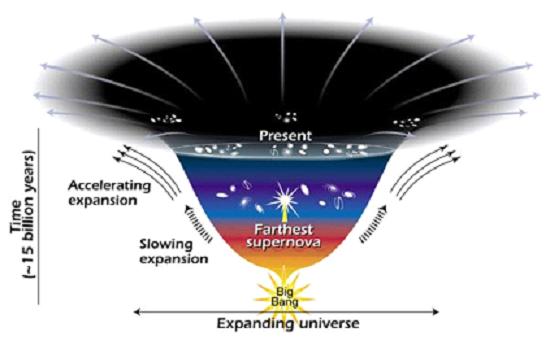
home •
about •
essential guide •
picture of the day •
thunderblogs •
news •
multimedia •
predictions •
products •
get involved •
contact
picture of the day archive subject index
Diagram of dark energy influence on the universe. Credit: NASA/HST
Oct 29, 2008
Is the Universe Recession Proof?
Cosmologists are no closer to solving the dark energy problem.In 1998, two astronomical research teams independently discovered what is now called "dark energy." Saul Perlmutter of the Lawrence Berkeley National Laboratory and Brian Schmidt from the Australian National University projects each led the two teams who discovered that the Hubble Constant, a uniform expansion rate imparted to the universe from the Big Bang explosion, was accelerating.
Certain concepts, like redshift and gravity, are fundamental to the Big Bang hypothesis. According to theory, light shifts toward the red end of the spectrum because an object is moving away. Because objects interpreted to be at great distances move away faster than objects nearer to Earth, the universe is expanding. The usual understanding is that galaxies are all moving away from each other because the universe is growing larger.
Another important principle is that the universe is gravity-driven. If gravity is the only controlling force, then the expansion set in motion by the Big Bang must be slowing down—an inescapable conclusion based on gravitational attraction.
However, Perlmutter and Schmidt realized from the study of Type 1a supernovae that the expansion of the universe was not slowing down, instead it was accelerating. When the astronomers plotted redshifted "velocities of recession," the figures suggested that the expansion rate of the universe is greater today than in its early days.
In order to analyze the influx of computer data from telescopes around the world and out in space, the GRavitational lEnsing Accuracy Testing 2008 (GREAT08) PASCAL Challenge, a group of 38 scientists from 19 international institutions, hopes to solve the riddle of dark acceleration in the Hubble Constant by 30 April 2009. Because the data is primarily images of supernovae and their spectrographs, the computational requirements could be distributed across a wide assortment of disciplines—some not necessarily in the astronomical realm. By making use of distributed processing, astronomers can unburden their own computer resources and use any number of voluntary subscribers for assistance. Who knows, in the near future your computer may be helping to remove image artifacts from Hubble Space Telescope data.But is all this effort necessary? Even some NASA scientists are questioning the existence of dark energy. What is the more likely explanation for the supernovae anomalies that led to the dark energy theory? Cosmologists made their first mistake when they ignored electricity as a significant force in the cosmos. For example, Supernova 1987a, the closest supernova to Earth ever studied, exhibits unmistakable signs of electrical discharge.
Size, color, and luminosity reveal nothing about a star's age. A red giant star is big because there is low electrical stress in the star's connected circuit. A blue-white star, on the other hand, is under extreme electrical stress—so much so that it could explode due to a breakdown in its double-layer envelope or due to electrical fissioning. No assumption about a star's age can help when trying to determine if it will explode. In fact, one aspect of high-energy plasma discharges is that they can produce redshifts that have no connection to recessional velocity.
The Supernova Legacy Survey discovered that the brighter supernovae were more common in the past and that they were about 12% brighter 8 billion years ago than they are now. No one knows why the early universe had more of the Type 1a supernovae. One observation does show a compelling clue: the brighter starbursts are found more often where there is a high rate of star formation.
As the Electric Universe postulates, more stars are born where there are greater flows of electric current. That current flow could also initiate a greater number of stellar explosions with anomalous luminosities and high redshifts. That would make highly charged, nearby objects undergoing electrical discharges to look like remote, high redshift supernovae that are too bright for their distance. One can imagine the theoretical problems that would result from that misinterpretation.
By Stephen Smith
___________________________________________________________________________
SPECIAL NOTE: We are pleased to announce a new e-book series "THE UNIVERSE ELECTRIC." Available now, the first volume of this series summarizes the failure of modern cosmology and offers a new electrical perspective on the cosmos. At over 200 pages, and
designed for broadest public appeal, it combines spectacular full-color graphics with lean and readily understandable text. High school and college students--and teachers in numerous fields--will love this book. So will a large audience of general readers.
Visitors to the Thunderbolts.info site have often wondered whether they could fully appreciate the Electric Universe without further formal education. The answer is given by this exquisitely designed book. Readers from virtually all backgrounds and education levels will find it easy to comprehend, from start to finish.
For the Thunderbolts Project, this series is a milestone. Please see for yourself by checking out the new Thunderbolts Project website, our leading edge in reaching new markets globally.Please visit our Forum
The Electric Sky and The Electric Universe available now!

|
|

|
EXECUTIVE EDITORS:
David Talbott, Wallace Thornhill
MANAGING EDITORS:
Steve Smith, Mel Acheson
CONTRIBUTING EDITORS: Michael Armstrong, Dwardu Cardona,
Ev Cochrane,
C.J. Ransom, Don Scott, Rens van der Sluijs, Ian Tresman
WEBMASTER: Brian Talbott
Copyright 2008: thunderbolts.info
![]()
home •
thunderblogs •
forum •
picture of the day •
resources •
team •
updates •
contact us

